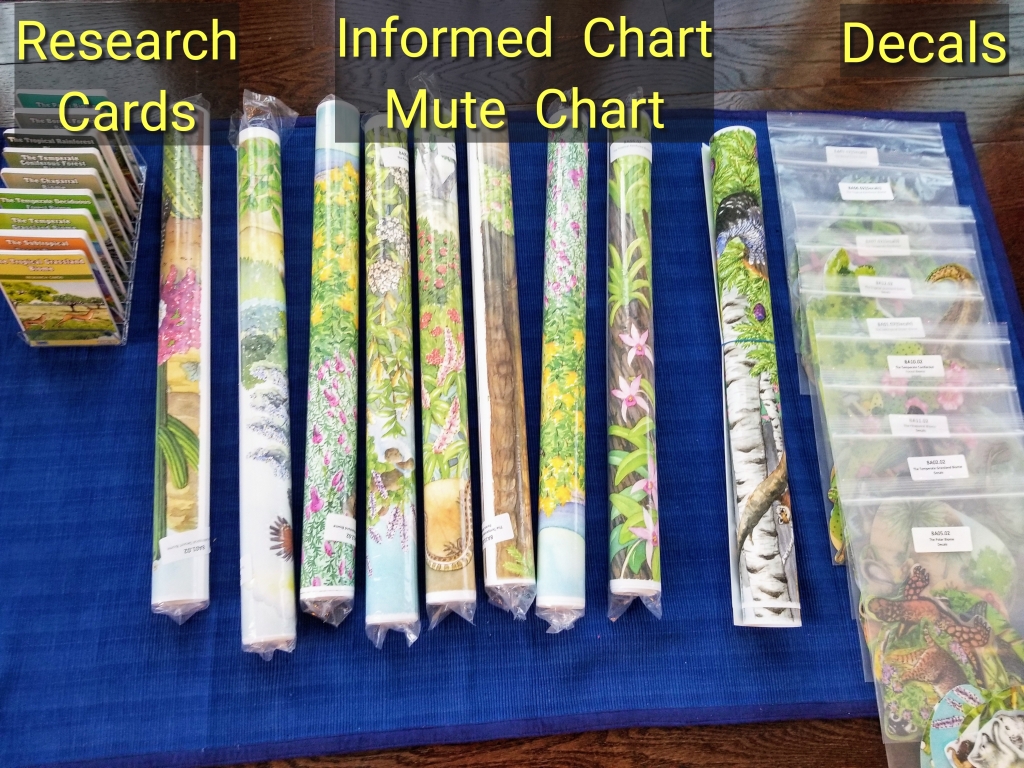- Biology, Geography 6-9

- Biomes are regions with similar climates and biota (plants and animals). There are aquatic biomes and terrestrial biomes. The terrestrial biomes can be divided in 9 distinctive biomes, which are represented in the materials, Biome Charts, by Alison’s Montessori.

Why we like the charts
- There is something remarkably unique about the Biome Charts. They provide a whole picture of a biome. With stunning graphics, the materials leave a gentle impression of the biome in question. The Biome Charts provide opportunities for kinesthetic work using decals on a mute chart, which should enhance the learning experience. In addition, each decal has a corresponding research card that can be read while placing the decals on the mute chart.
- The research cards lead to understanding the interrelationship between animals and plants, and their environmental factors. They also demonstrate ways in which animals and plants adapt to these enviromental factors. While reading, the children encountered vocabulary that pertains to their zoology and botanical studies. It’s always good that they see their knowledge as being interdisciplinary.
Materials
- There are 9 charts available: Tropical Grassland, Subtropical Desert, Temperate Grassland, Temperate Deciduous Forest, Chaparral, Temperate Coniferous Forest, Tropical Rainforest, Boreal Forest, Polar.

- Each chart contains: 1 informed chart, 1 mute chart, 10-12 decals, 10-12 research cards


How we used the charts
- Each set is comprised of 2 charts, decals, and research cards. I presented the children with a map depicting the biomes of the world, similar to the charts. We observed where each biome was located, Then they chose a biome to explore, the Boreal Forest Biome, since it is in North America.
- I let the children bring the chart with the corresponding materials. We did this first chart together for modeling. We first practiced with the informed chart next to the mute chart, and laid out all the decals and all research cards on a mat. Each child got to select an animal or a plant from the research cards. They then read the research card of their choice aloud, while the other child placed the corresponding decal on the mute chart.

Research Cards and Decals
- After this work, you can invite the children to read a book on the topic. You can also introduce a book before working with the charts. The children can create booklets with their own art, and even create a 3D diorama based on the chart. My children started a diorama, and will be researching and writing about a plant or an animal of their choice in their journal. This practice gives them an opportunity to practice their research skills, writing skills, drawing skills, and independent work!

***I hope you enjoyed my review on the Biomes Charts from Alison’s Montessori. The material was provided by Alison’s Montessori, at no cost. This honest review is meant to share with you the content and aesthetic aspect of the materials. I enjoy sharing how we use it with my learners. They are many creative ways of using such versatile materials!***
- Do your learners enjoy the Biomes study? What is their favorite biome? Please leave your comment and questions in the comment box, I’d be happy to talk with you!

- Ready for a presentation? Please subscribe by following to receive notifications for my next review!


